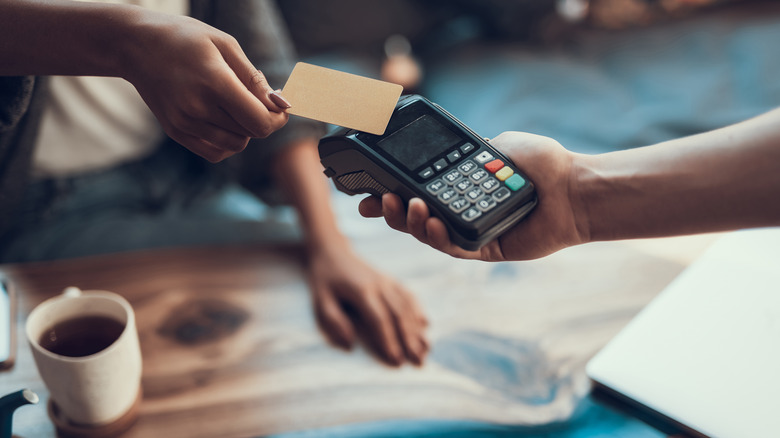The No-Spend Challenge Is The Latest BS Trend To Gatekeep You From True Financial Freedom
There's a new financial trend that's gaining an impressive amount of traction on social media known as the no-spend challenge. The challenge is a set period of time that an individual decides on, where they spend nothing except what they consider essential spending. This includes rent or mortgage costs, utilities, groceries, and any other non-negotiable expenses. Conversely, an individual typically makes a list of things that they're not allowed to spend money on. The trend, at least as it's presented on social media, is typically visual too. On days when someone spent nothing or only spent money on allowed expenses, they fill in the calendar day with green. Then, on days where they failed their challenge, they mark off the calendar in red.
TikTok user @lilyrnbudgets shared her calendar during her no-spend challenge with a list of allowed expenses including bills, beauty, and planned travel. What was not allowed included eating out, online shopping, and coffee shops. TikTok user @madsashlee shared her challenge and showed her list of allowed spending, which included basic living expenses, as well as a date night once a month with her husband, and pet care.
While the no-spend challenge can certainly be adaptable — each person is encouraged to craft a list of what's allowed and what's not allowed — the challenge is inherently restrictive by its very nature. It promises to expedite financial goals, be they debt reduction, an increase in savings, or to pay for a specific thing. However, the no-spend challenge can actually be a bad financial move. Here's why.
Why the no-spend challenge is ineffective
While the no-spend challenge promises to reduce spending, it's actually not an effective strategy to achieve financial freedom. Why? Because the challenge hinges entirely on restriction. We can activate willpower for a time, but this isn't effective in the same way that crash dieting isn't a sustainable long-term health plan. Financial guide Alicia McElhaney told CNBC that she's wary of the no-spend challenge because it prompts the same toxic restraint of diet culture. She points out, "I've seen quite a bit more talk about dieting, body hate, and discomfort with fatness on social media in personal finance circles than I expected when I first got into this."
In a separate interview, financial planner Kendall Meade also spoke told CNBC about how financial restrictions can backfire. Once the no-spend challenge ends, she explains the downfall saying, "What I think is a big con for it is that it can cause what I call 'revenge spending.' Sometimes I see that you actually end up spending more because you tried to cut out so much the week before."
The challenge can also fail because it doesn't dig deeper into some underlying reasons behind spending problems. TikTok user @itslexilarson began her no-challenge video by saying that she has a serious shopping addiction. While she might have just been using the term as an expression, shopping addiction is a legitimate psychological condition, as people shop to feel the endorphins and dopamine that come from making a purchase. The no-spend challenge curbs this for a brief period of time but doesn't get to the root of the deeper problem.
When it does work
There are a few occasions when the no-spend challenge can be effective. Certified financial planner Lauren Anastasio told CNBC that the challenge can be positive when there's a very specific goal in mind. This can be to pay off a credit card or to save up for something measurable, like a trip or a large purchase. The saved money can go directly towards debt reduction or a fund, and this can be an effective way to accomplish those goals.
Another way that the no-spend challenge can be effective is that it can open people's eyes to their own budgets if they're not in the practice of keeping one. The challenge forces us to be very aware of and intentional about our spending, which can be a good headspace to get into in general when it comes to money. As Meade told CNBC, "People realize when they're going through these no-spend times, 'what was I spending on that wasn't that important to me, what really doesn't affect my life?'"
However, the no-spend challenge doesn't look at why we might have gotten into credit card debt in the first place. Sure, it may work to pay off debt quickly. But it might not create sustainable, lasting financial change that would preclude us from falling into debt again.
What's the solution?
If the no-spend challenge is only effective in short-term cases, what's the best practice for gaining financial freedom? Certified financial planner Monica Sipes told CNBC that taking the time to make a realistic budget and sticking to it, would do more good. "Ultimately, it comes down to why you are making the decisions around your money, not a temporary restriction to undo bad spending habits," Sipes explained.
The most effective budgets aren't necessarily restrictive. Financial planner Lauren Anastasio told the outlet that the goal is to become more aware of where our money goes. Perform regular check-ins with your finances. Then, alter your plan as you notice what needs to be changed or isn't working. "Reevaluate your plan and make adjustments," Anastasio explained.
Her firm, SoFi, suggests following the 50/30/20 guide to gain financial freedom. 50% of your income goes to bills and recurring expenses, while 30% goes towards wants, and 20% goes into savings and investments. This strategy can lead to long-term financial ease because you're still allocated a portion of your budget for wants. This does away with the troubling concept of restriction, which can often come with self-loathing and a sense of defeat if you fail. Instead, a workable, realistic budget means that you can practice financial responsibility while still enjoying some of your hard-earned cash.



